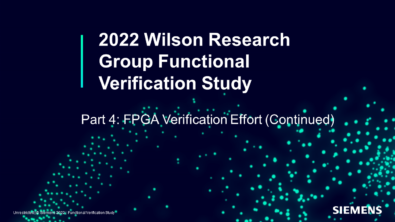Verification Issues Take Center Stage
Is Legacy Holding You Back?
Harry Foster, Mentor’s Verification Chief Scientist, will take center stage to give live presentations on the pressing SoC verification issues as he highlights recent research he has been reporting on in his numerous blogs. The first event will be held in San Jose, CA USA (18 October 2011) and the second event will be held in Reading, UK (15 November 2011).
Harry has been reporting on the 2010 Wilson Research Group Functional Verification Study that has shown a rapid market move towards the broadly supported SystemVerilog (IEEE 1800) language standard and ubiquitous support of the OVM/UVM methodologies. While humans have a general disdain for change, human nature also seems to wait to respond to the “crowd effect” to make a change. It appears the market is in the throes of this strain as the market moves in a direction leaving legacy behind.
To learn firsthand from Harry, I recommend attending two upcoming events where he will speak:
Date: 18 October 2011 (Tuesday)
Event: Design & Verification in the SoC Era
Location: DoubleTree – San Jose, CA USA
Website: http://www.mentor.com/events/verification/
Cost: Free; registration restrictions apply
Date: 15 November 2011 (Tuesday)
Event: Verification Futures: The Next Five Years
Location: Hilton Hotel, Reading, UK
Website: http://verificationfutures2011.eventbrite.com/
Cost: Free
Legacy set for replacement?
Have you ever noticed that one restaurant alone may get little traffic, but if there are many restaurants clustered together, they garner much greater traffic than going it alone? The crowd effect demonstrates its power and user benefit with choice and bounty. After DVCon 2011, I blogged about Wally Rhines’ keynote address and pointed to one slide that showed SystemVerilog is the clear language winner and pointed to another slide that showed OVM/UVM, built on top of SystemVerilog, as the clear methodology winner.
This has impact on legacy. And those with entrenched legacy may find it hard to adopt market driven standards practice quickly. This is to be expected.
When Accellera began its Verification IP Technical Subcommittee (VIP-TSC), I argued that the first step is to preserve legacy investment and offer a path to reuse that which has proven valuable in the past. The vote to move in this direction was close with consumer input saying all efforts should focus on a single industry supported base class library and standard. My point was we could build it, but if there was no path from where consumers were, there would be limited uptake. In a short time, a proof that OVM and VMM could interoperate demonstrated that we knew how to do this. It also gave hope that other proprietary and single-supplier solutions could take this work and adapt it for their paths forward.
With that finished, the Accellera VIP-TSC set to create the Universal Verification Methodology (UVM) standard. This has now been completed, short of finishing one commitment to expand the Phasing scheme and address a few lingering issues. While Accellera could focus on completing this work, users and owners of legacy verification languages and proprietary environments have come to realize a startling truth: the market has moved away from them. And, proprietary and single-solution suppliers have offered little in terms of paths forward. They now look for Accellera to address legacy preservation requirements and do it for them.
While this was to be expected, their shock has exposed the fact that more work could have been done on building the bridges to legacy’s past in the initial phase rather than now when the market demands time and focus on its adopted standards practice instead.
Why bring all this up?
We now find the Accellera VIP-TSC has a bifurcated focus. Part of the focus is to complete the content promises for UVM 1.0 and the other is to preserve legacy investment. But can Accellera overcome the crowd effect? The crowd effect, after all, has taken hold. In terms of product choice, legacy offers one product from a single supplier to SystemVerilog’s multiple competitive suppliers. When it comes to bounty, the availability of legacy verification IP has fewer and fewer sources while OVM/UVM offer an expanding bounty.
In the face of this rapid market move, one can expect single solution suppliers will extol features of their solution over the market’s choice. Users faced with the grim prospect of having to adapt to market changes will praise the past in hopes others will depart from the crowd. I am at a loss to think of a time when actions like this have worked to change the market. Maybe someone knows of examples and can share them.
In fact, I was a user who praised the technical benefits of one format over another. I made further investments in it. I even moved to a new job in a new area to find the community I moved to seemed to favor my selected format equally with what was to be the market winner. In time, in very short time, even my new community gave way to the market and the crowd. Can you guess what that format was?
I will share the details this with you next week when I discuss how one might actually bring value to legacy while allowing the market to continue its move forward. In the meantime, if you are close to the San Jose, CA or Reading, UK events, I suggest you register to attend.


